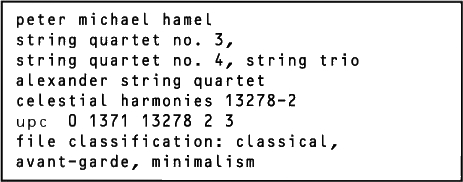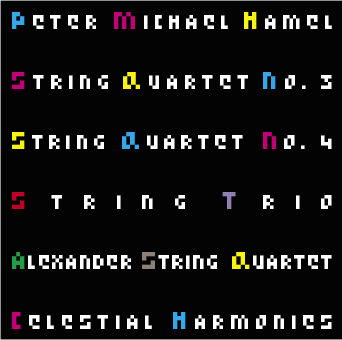 |
||||||||||||||||||||||||||||||||||||||||||||||||||||||||||||
 
the projectThroughout music history chamber music has employed a small range of instruments to create music directed at modest groups of individuals who were both well educated and experienced listeners. In turn, this has allowed composers to present new, unusual, and even shocking and 'unheard of' compositions. In particular, it has been the role of the string quartet to help realise that which is pragmatically novel. Writes Peter Michael Hamel "My first quartet became a work for discovering my means of articulation, for finding ways to integrate new elements into my compositions. Four individuals listening to one another can do far more than that too, which is what is decisive in creating innovative and pragmatic new music...". In String Quartet No. 3, composed between 1991 and 1993, Hamel incorporated experiences that he had with traditional music gained during a period at a South Korean monastery. In the monastery, Hamel was able to integrate himself into everyday religious (Buddhist) life and establish a relationship to the pentatonic archetypes of Korean music. Hamel personally describes the processing of the experiences as Anverwandlung (an adaptation) as opposed to an amalgamation. He writes "The better we get to know the cultures of the Far East or other non-European cultures in general, or even the roots of our own ancient European music, the more we respect them and avoid merging them together into a single global music. That is to say, I conducted an exhaustive study of the tonal systems and rhythms and did not simply adopt these." String Quartet No. 4 Nachklänge (Echoes) in five parts was composed between 1995 and 2000. The subheading refers partly to other self-composed works as well as to individuals who were formative to Hamel's work. The 1st movement, for example, is dedicated to his friend and teacher Günter Bialas, whose death in 1995 motivated Hamel to compose this string quartet. The string trio, composed between 1991 and 1992, was a reflection
on String Quartets Nos. 1 and 2. Each represents a summary of
said works, in so much as it further interprets the basic structures
experimented with therein. The challenge for Hamel lay in the
difficulties posed by having only three instruments at his disposal,
which by its very nature limits the tonal and harmonic possibilities
yet further. The genre of the string trio also has a venerated
history, but it has never gained the popularity as the string
quartet for the aforementioned reason. This places additional
demands on the composer to be even more precise in the use of
his means of expression to convey his message. Scores and parts for all three works are available from Celestial Harmonies. the artists/composerHaving celebrated its 25th Anniversary in 2006, the Alexander String Quartet has performed in the major music capitals of four continents, securing its standing among the world's premier ensembles. Widely admired for its interpretations of Beethoven, Mozart and Shostakovich, the quartet has also established itself as an important advocate of new music through over 25 commissions and numerous premiere performances. Of their performance of the Shostakovich string quartet cycle in April 2006, The New York Times wrote" The intimacy of the music came through with enhanced power and poignancy in the Alexander quartet's vibrant, probing, assured and aptly volatile performances." At home in San Francisco, the members of the Alexander String Quartet are a major artistic presence, serving as Ensemble in Residence of San Francisco Performances and as directors of the Morrison Chamber Music Center at the School of Music and Dance in the College of Creative Art at San Francisco State University. The Alexander String Quartet was formed in New York City in 1981 and the following year became the first string quartet to win the Concert Artists Guild Competition. In 1985, the Quartet captured international attention as the first and only American quartet to win the London International String Quartet Competition, receiving both the jury's highest award and the Audience Prize. In May of 1995, Allegheny College awarded Honorary Doctor of Fine Arts degrees to the members of the quartet in recognition of their unique contribution to the arts. Peter Michael Hamel, born in 1947, ranks as one of the best known and most successful German composers of his generation. He studied music, psychology, and sociology in Munich and Berlin with teachers such as G. Bialas, F. Büchtger, and continued his education abroad, spending three extensive periods in Asia. Hamel has entered into an intense engagement with musical culture from outside Europe, especially the music of India. He has drawn inspiration from Asian philosophies and religions and from his encounters with the works of Jean Gebser and C.G. Jung to present a music that seeks to make itself accessible to the listener through meditative experience and self-exploration. Peter Michael Hamel's other works on Kuckuck Schallplatten/Celestial Harmonies include Colours of Time/Bardo (12046-2), Transition (12063-2), Organum (11074-2), Let It Play: Selected Pieces 1979-1983 (11078-2), The Arrow of Time/The Cycle of Time (11093-2), De Visione Dei (13193-2) and recorded by Roger Woodward, Vom Klang des Lebens / Of the Sound of Life (13256-2). biographydiscography
|
| 3. streichquartett in drei teilen / | ||
| 3. string quartet in three parts | ||
| (1991/93) | 20'22" | |
| 1 | hyang-ak | 6'01" |
| 2 | mu-ak | 4'39" |
| 3 | a-ak | 9'34" |
| 4. streichquartett in fünf teilen / | ||
| 4. string quartet in five parts | ||
| nachklänge / echoes (1995/2000) | 21'29" | |
| 4 | part 1 | 4'37" |
| 5 | part 2 | 3'11" |
| 6 | part 3 | 5'12" |
| 7 | part 4 | 1'40" |
| 8 | part 5 | 6'29" |
| streichtrio / string trio (1991/92) | 35'22" | |
| 9 | largo | 10'54" |
| 10 | vivace | 6'32" |
| 11 | scherzo | 5'16" |
| 12 | adagio | 12'23" |
| Total Time: | 77'30" |



